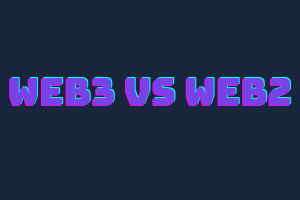The internet as we know it is constantly evolving. From the early days of static websites to the dynamic and interactive Web2, we are now on the cusp of a new era: Web3. But what exactly is Web3, and why is it being hailed as the future of the internet?
In this article, we will delve into the world of Web3 and explore its key features and benefits. We will examine how decentralization is the key to Web3’s potential, and how blockchain technology is playing a crucial role in this new paradigm. We will also look at some real-world examples of Web3 applications and how they are being used today.
But with any new technology, there are also challenges to adoption. We will discuss the regulatory and educational hurdles that must be overcome for Web3 to become mainstream. Finally, we will explore the future implications of Web3 and how it could fundamentally change the internet as we know it.
If you want to know about web3, read this article that explains everything you need to know
If you’re interested in exploring this exciting new frontier, we’ll also provide some tips on how to get involved in Web3 and start contributing to the movement. So buckle up and get ready to discover why Web3 is the future of the internet.
Understanding Web3: What it is and how it differs from Web2
Web3 is the third generation of the internet, which is still in its early stages of development. Web1 was the first generation of the internet, characterized by simple HTML websites, static pages, and limited interactivity. Web2, which emerged in the mid-2000s, introduced dynamic, interactive websites, social media platforms, and cloud-based services that allowed users to create, share, and collaborate online.
Web3 builds on the foundations of Web2 but with one critical difference: decentralization. Decentralization refers to the idea that power should be distributed among many individuals and groups, rather than concentrated in the hands of a few central authorities. In Web3, decentralization is achieved through the use of blockchain technology, which enables the creation of decentralized applications (dApps) that run on a peer-to-peer network of computers, rather than on centralized servers.
Decentralization: The key to Web3’s potential and future of the internet
The key to Web3’s potential lies in its decentralized architecture, which offers several advantages over the centralized Web2. First, decentralization offers increased privacy, as data is stored on a distributed network of computers, making it harder for third parties to access and exploit. Second, decentralization offers increased security, as there is no central point of failure that can be attacked or compromised. Third, decentralization offers increased ownership, as users have more control over their data and assets, rather than relying on centralized platforms to manage them.
Decentralization also enables the creation of new business models, where users can be rewarded for their contributions to the network, rather than simply being exploited for their data. For example, in a decentralized social media platform, users could earn cryptocurrency tokens for creating content, curating content, or engaging with other users, creating a more equitable and sustainable ecosystem.
The benefits of Web3: Increased privacy, security, and ownership
The benefits of Web3 are many and varied, but they all stem from its decentralized architecture. Here are a few of the key benefits:
Increased privacy: With data stored on a distributed network of computers, it’s much harder for third parties to access and exploit user data. This means that users can feel more secure in their online interactions, knowing that their personal information is less likely to be compromised.
Increased security: With no central point of failure, there’s no single point that can be attacked or compromised. This makes Web3 platforms more resistant to hacking and other cyber attacks, making them a more secure option for online interactions.
Increased ownership: With users in control of their data and assets, rather than relying on centralized platforms to manage them, users have more control over their online identities and can more easily monetize their contributions to the network.
New business models: Web3 enables the creation of new business models, where users can be rewarded for their contributions to the network, creating a more equitable and sustainable ecosystem. For example, in a decentralized finance (DeFi) platform, users can earn interest on their cryptocurrency holdings, rather than relying on traditional banks that often offer lower interest rates.
The role of blockchain technology in Web3
Blockchain technology is the backbone of Web3, enabling the creation of decentralized networks and applications. At its core, a blockchain is a decentralized ledger of transactions that is stored on a distributed network of computers. Each block in the chain contains a record of multiple transactions, and once a block is added to the chain, it cannot be altered or deleted.
This immutability makes blockchains a secure and transparent way to store data, and it’s what enables decentralized applications to function. In a decentralized application, data is stored on the blockchain, and transactions are verified by a network of nodes that work together to reach consensus on the state of the network.
Blockchains also enable the creation of cryptocurrency tokens, which can be used as a medium of exchange within the network. These tokens can be traded on cryptocurrency exchanges, giving them real-world value.
Web3 applications: Examples of how it’s being used today
Web3 is still in its early stages of development, but there are already several examples of how it’s being used today. Here are a few examples:
Decentralized finance (DeFi): DeFi platforms are decentralized applications that enable users to earn interest on their cryptocurrency holdings, borrow and lend cryptocurrency, and trade cryptocurrency tokens without the need for intermediaries like banks or brokers.
Decentralized social media: Decentralized social media platforms are alternatives to centralized social media platforms like Facebook and Twitter. These platforms are built on a decentralized architecture, and users have more control over their data and privacy.
Decentralized marketplaces: Decentralized marketplaces like OpenSea and Rarible enable users to buy and sell digital assets like artwork, music, and collectibles without the need for intermediaries.
The challenges of Web3 adoption
While the potential benefits of Web3 are significant, there are several challenges that need to be overcome before widespread adoption can be achieved. Some of the main challenges include regulation, education, and infrastructure.
Regulation: One of the biggest challenges facing Web3 is the lack of regulatory clarity. As decentralized applications become more popular, governments and regulatory bodies are beginning to take notice. However, the regulatory landscape is still uncertain, and there’s a risk that heavy-handed regulation could stifle innovation in the space. Finding the right balance between innovation and regulation will be critical to the success of Web3.
Education: Another challenge facing Web3 is education. While there’s growing awareness of blockchain and cryptocurrency, many people still don’t understand the potential of decentralized applications. There’s a need for more education and outreach to help people understand the benefits of Web3 and how to use it. This includes education for developers, investors, and the general public.
Infrastructure: Finally, infrastructure is another key challenge facing Web3. Decentralized applications require a robust and scalable infrastructure to function properly. While there have been significant improvements in blockchain infrastructure in recent years, there’s still a long way to go before Web3 can compete with the centralized web in terms of speed and scalability. Improvements in infrastructure will be critical to the success of Web3.
Overcoming these challenges will require collaboration and innovation from a wide range of stakeholders, including developers, investors, regulators, and users. Despite the challenges, the potential benefits of Web3 are too significant to ignore, and there’s reason to be optimistic about its future. As more people begin to understand the potential of Web3 and more resources are devoted to its development, we’re likely to see significant progress in the coming years.
Future implications: How Web3 could change the internet as we know it
Web3 has the potential to change the internet as we know it in several ways. Here are a few possibilities:
A more equitable internet: Web3 could enable a more equitable internet, where users have more control over their data and assets and can be rewarded for their contributions to the network.
A more secure internet: With no central point of failure, Web3 platforms are more resistant to hacking and other cyber attacks, making them a more secure option for online interactions.
A more decentralized internet: Web3 is all about decentralization, and it could lead to a more decentralized internet, where power is distributed among many individuals and groups, rather than concentrated in the hands of a few central authorities.
Getting involved in Web3: How to start exploring and contributing to the movement
If you’re interested in exploring Web3 and contributing to the movement, there are several things you can do:
Educate yourself: Start by learning more about Web3 and the technologies that underpin it. There are many resources available online, including blogs, forums, and social media groups.
Experiment with decentralized applications: Try out some decentralized applications for yourself to get a feel for how they work and what they offer. Some popular decentralized applications include Uniswap, MetaMask, and Compound.
Contribute to open-source projects: Many Web3 projects are open-source, meaning anyone can contribute code, documentation, or other resources to help improve the project. Look for open-source projects that align with your interests and skills.
Join online communities: There are many online communities focused on Web3 and decentralized technologies, including forums, social media groups, and Discord channels. Joining these communities can be a great way to connect with like-minded individuals and stay up-to-date on the latest developments in the space.
Conclusion
Want to learn more about web3? Become a certified web3 expert today. learn more
Web3 represents a new paradigm for the internet, one that’s decentralized, secure, and equitable. With blockchain technology as its backbone, Web3 enables the creation of decentralized applications that can revolutionize the way we interact with each other online. While there are still challenges to its adoption, including regulation and education, the potential benefits of Web3 are significant, and we’re likely to see more and more Web3 applications in the coming years.
If you’re interested in exploring Web3 and contributing to the movement, there are many resources available to help you get started. Whether you’re a developer, designer, or just someone who’s curious about the future of the internet, Web3 offers exciting possibilities for innovation and progress.



